Some
City Point Research
Valuable
Resources
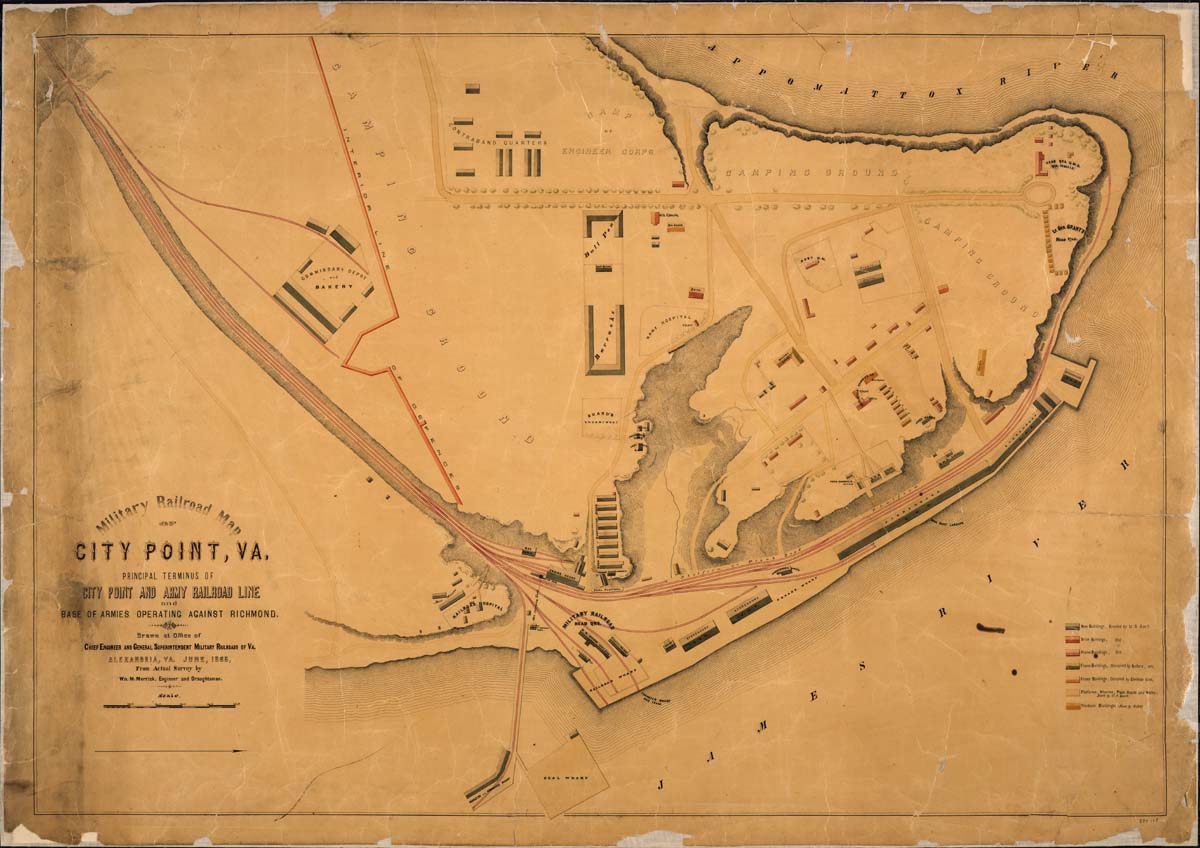
Merricks City War Map of City Point
This project
got started when I found a high resolution digitized copy of the map of
the City Point area
that was created just after the war by W. M. Merrick. It can
be downloaded
from the University of Maryland. The URL is http://narademo.umiacs.umd.edu/cgi-bin/isadg/viewitem.pl?item=105738.
- I also put a (164 megabyte) copy of the map here on my site, just in case the University of Maryland loses it.
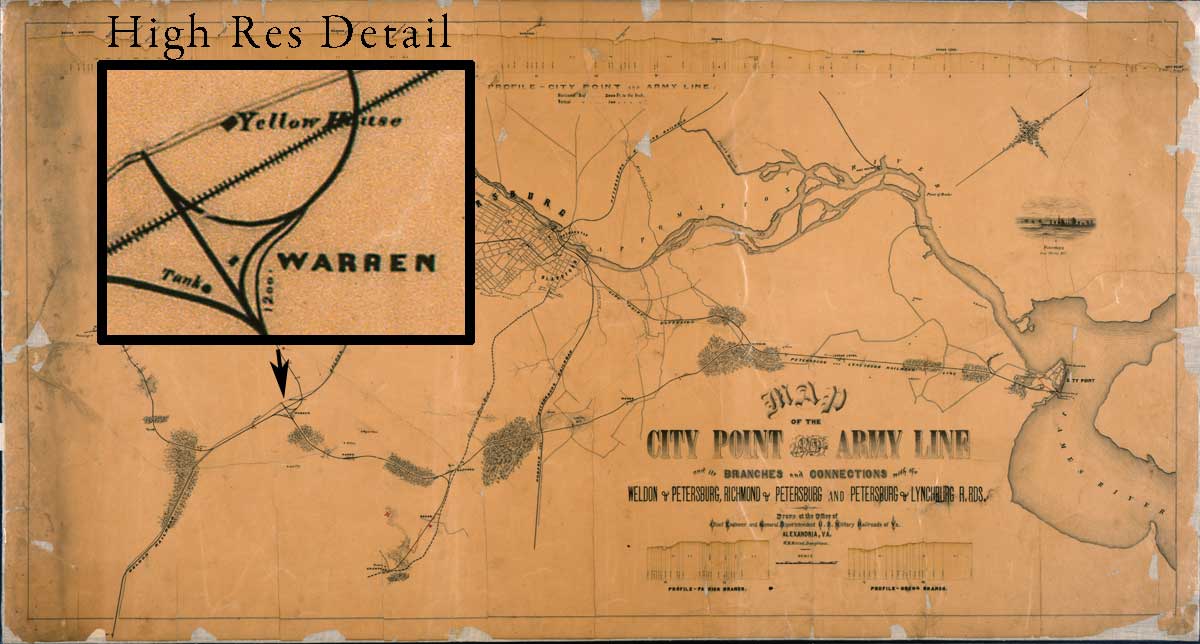
- A (231 megabyte) map of the entire City Point and Army Line can be downloaded from here. I had this map scanned from a high resolution image of the original.
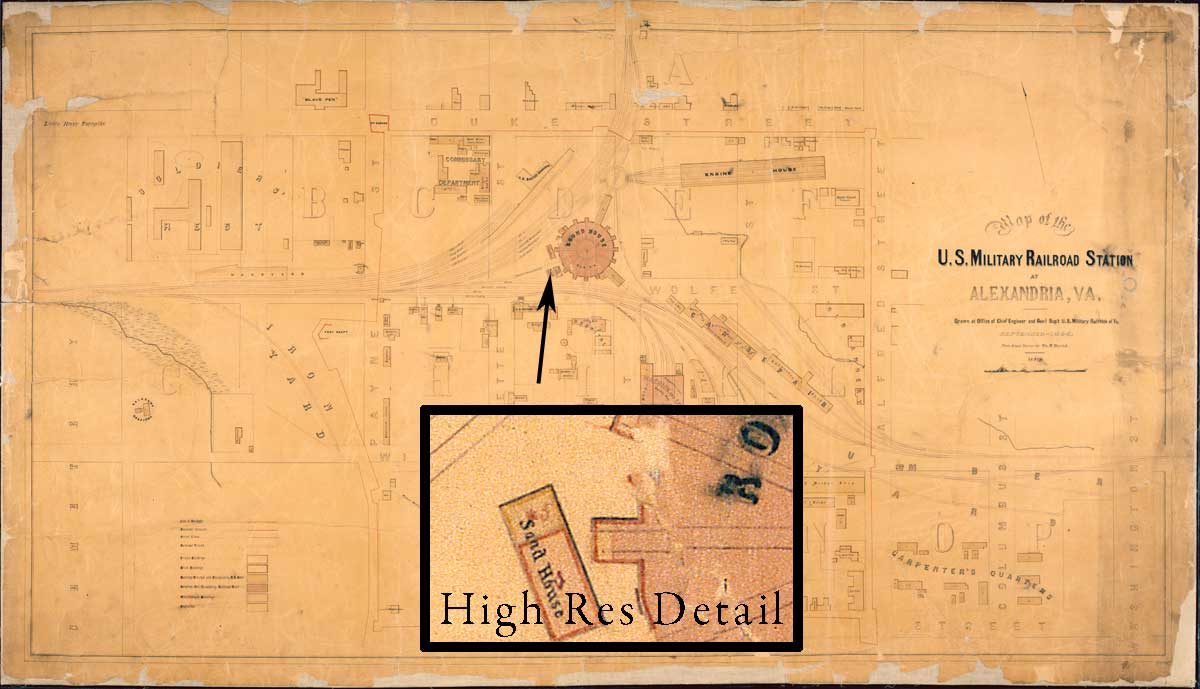
- A (269 megabyte) map of Alexandria depot can be found here. I also had this map scanned from a high resolution image of the original.
Special Interest Groups
There is also a yahoo group in which the participants have
been doing a lot research and sharing a lot of information. This URL is http://groups.yahoo.com/group/Civil_War_RRs/.
Searching the archives, files, photos and links section of
this
group can yield a lot of information.
Official Records
Also some information
can
be found in the official records, including year end reports and a
summary of railroad operations of the entire war. Both
Cornell
University and Ohio State univeristy have online searchable copies.
The URLs are http://digital.library.cornell.edu/m/moawar/waro.html
and http://ehistory.osu.edu/osu/sources/records/.
Historic Photographs
Both the Library of Congress and National Archives have
online
digitized photographs of City Point taken during the war. The
URLs for the online search engines are http://www.archives.gov/research/arc/
and http://lcweb2.loc.gov/pp/cwpquery.html.
Be aware that finding useful search criteria can be
challenging
at times and that some images are misidentified in terms of date and
location.
Books
The
City Point story seems like it should be told in detail in a book with
a number high quality photograpsh reproduced within. Most Civil
War books I've seen have extremely poor reproduction of the originals
Many surviving civil war photos actually have amazing resolution
and contrast. Take a look at the high resolution scans available
for download from the Library of Congress.
The book "Civil War
Railroads & Models" by Edwin P. Alexander has a number of photos of
City Point. Most of these photos are from the National Archives.
Except for the jacket, the images are not of great quality, but are
better than the thumbnails found on the National Archives site.
The text is limited. I was able to borrow this book through
inter-library loan from my local library and have scanned the City
Point relavant pages for future personal reference.
National Archives
The
ultimate resource would be a trip to the National Archives
itself.
Though I haven't made such a trip Bernard Kempinski has
provided
some tips and information on his blog pages. The URL for his
blog
is http://usmrr.blogspot.com/search/label/Archives.
Berndard also has put information on City Point and several
track
plans into his book "Mid-Size Track Plans for Realistic Layouts",
available from Alkem Scale Models at this link http://www.geocities.com/bkempins/ASMMain/TrackPlanBook.html.
Some
Background
The
US Army was at City point for over a
year. There can be
found several photographs of the yard and wharfs taken at different
times during the last year of the war. The Army
dramatically improved the facilities to such an extent that the before
and after photographs hardly are recognizable as the same
place. My model railroad might be modeled
on what existed before the final version that
was mapped by Merrick. His map was drawn after the close of
hostilities.
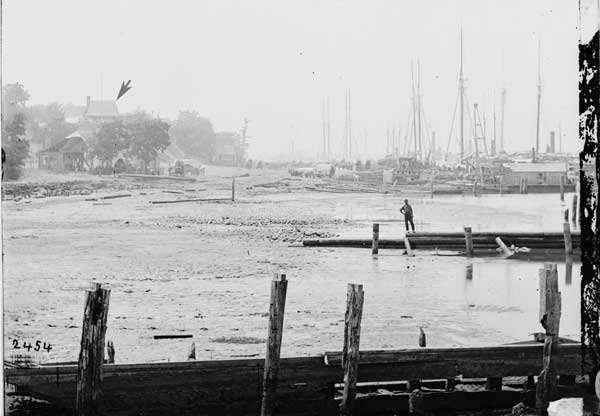
Library of Congress - LC-USZ62-102739
Above and below are two views that show
the extent of the change that occurred during development of the City
Point facilities.
Note the house on the bluff that is about the only thing that
tells us
that these are almost the same views. These
pictures were taken from
the area of the railroad wharf, looking west or upstream,
This
position is towards the left of the Merrick map, looking along the river toward the center of the
map.
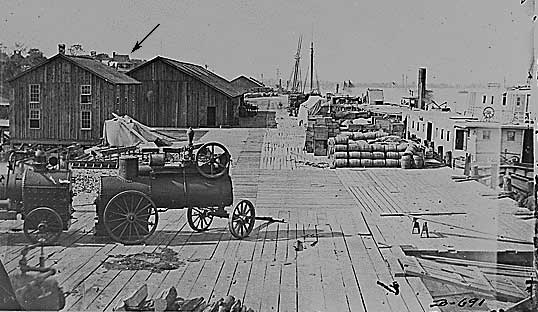
National Archives - 525096
I
love the steam engines seen in this photograph. Steam
engines were used to pump water from the river to the water towers near
the engine house, and also at the main army hospital in order to
provide running water for sick and wounded soldiers. I
believe
that they were also used to saw lumber to size in the lumber yard.
Other
photographs show steam driven pile drivers that were used in
construction of the port.
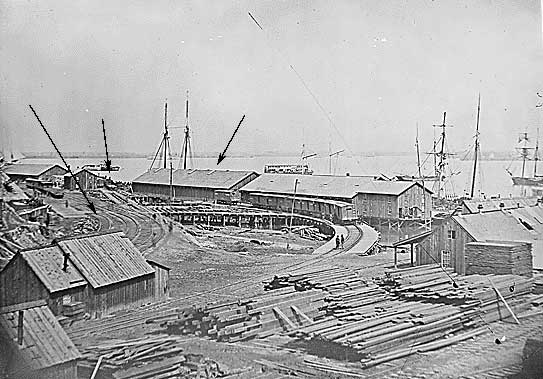
National Archives - 524482
Above
is a view that closely corresponds to the Merrick maps. Note
the tracks(on left) and warehouse (middle left).
There is a end
of year
(FY1865) report by D.C. McCallum, Superintendent of Military
Railroad in Virgina in the Official Records. That report gives an
indication when this warehouse was put up.
"Not much of note in railroad affairs
occurred from February 28 to April
3. The construction department was kept busy making additional
improvements wherever needed, and building a wharf at City Point, in
the gap between the quartermaster's and railroad wharves."
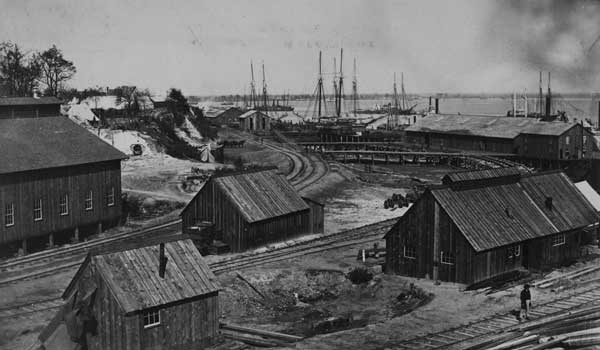
Library of Congress - LC-DIG-ppmsca-08248
This
very similar view of
the rail yard and
the warehouses
shows less trackage and fewer structures than found on the Merrick
maps. This
particular photograph was taken by A.J. Russel, army photographer.
The extra tracks and warehouse pointed out in the previous
picture are not present. However the building on the far right,
is no longer present in the later view and either burned or was torn
down. It
would be nice to find a way to date this particular view.
I'm hoping to date my model
railroad during
the time of a significant
troop movement. Right now, I'm trying to determine the extent of
construction done before the return of the 6th corps from the
Shenandoah
Vally at the beginning of December 1864. The engine house and
turntable was put in October. Seems like other structures were done
right about this time frame. The following statement is taken
from McCallum's end of year report.
"From November 10 to December 19 the
construction force were busily
engaged in constructing hospital buildings, repairing wharves, laying
additional side tracks, and building quarters for the Quartermaster's
Department and railroad employees. A large clothing warehouse and
extensive commissary buildings were then built; also distribution
barracks for the accommodation of the troops passing through City
Point. The coal wharf at City Point and a large wharf at Bermuda
Hundred were also completed."
I don't know of any other major troop
movement,
after the return of the sixth corp and prior to Grant's breakthrough in
early April. The movement of the 24th
corps to Fortress Monroe (and eventually Fort Fisher) in early January
1865, was through Bermuda Hundred landing, not City Point.
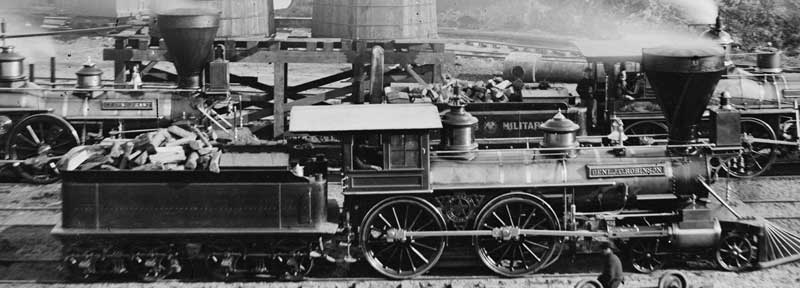
Library of Congress - LC-DIG-cwpb-01858 (cropped): Lieut. General Grant, General Robinson, Governor NyeLocomotives
Used on The City Point and Army Line
McCallum's report also
lists 55 locomotives on the roster
in Virgina at the end of the year. I've been working to
determine which ones were in use at City Point. There are
several
articles that state that there were 25 locomotives and 275
cars
on the City Point and Army line. I've been having a hard time
imagining where all these locomotives and cars are kept, since at most
only three or four locomotives can be seen in any photo of the yard at
City Point. I have a hunch that these articles are in error, and are
based
on a misunderstanding. There is a note in McCallum's report
that
24 new locomotives and 275 cars of 5 foot gauge were moved to
Manchester, VA at the close of the war. My assumption is that
these were intended to be used to supply the US army's final occupation
of the South on it's predominately 5 foot gauge railroads.
The
City Point and Army line was standard gauge. In the end these
locomotives and cars were sold and never used by the USMRR.
McCallum's
report does list the value of property on each line. Total
value
of the locomotives in Virginia was 879,000. The value of
locomotives on the City Point and Army line was only 125,000 or about
15% of total value. There were 55 locomotives listed, if
value of
each loco was about the same, then there would be 8 locomotives on this
line at this time. This sort of number might be a little low,
but
I think is closer to the mark, given the amount of yard track
and
sidings available.
That said, so far I have been able to
document 21 locomotives that have been on the line at one time or
another through either pictures found at various online archives,
websites, interest groups, as well as the wonderful timetable
that Bernard Kempinski has added to his blog. I have put online an animated map of the "City Point and Army Line" showing the hour by hour movement of trains for this timetable. Hopefully
Bernard
can find time to put up more timetables in order to firm up the locomotive list a
bit more.
| source |
locomotive |
| photo & timetable |
General Dix |
| photo |
Governor Nye |
| photo |
President |
| photo |
General Robinson |
| photo |
Lieut. General Grant |
| photo | Col Beckwith |
| timetable |
C. Vibbard |
| timetable |
Geo. A. Parker |
| timetable |
Fire Fly |
| timetable |
May Queen |
| timetable |
Pickwick |
| timetable |
Tiger |
| Civil_War_RRs
post #7486 | Indiana |
| Civil_War_RRs
post #7486 | Monitor |
| Civil_War_RRs
post #7486 | General McClellan |
| Civil_War_RRs
post #7486 | General McCallum |
| Civil_War_RRs
post #7486 | E.M. Stanton |
| Civil_War_RRs
post #7486 | H.L. Robinson |
| Civil_War_RRs
post #7486 | Humming Bird |
| Civil_War_RRs
post #7486 | Hiawatha |
| Civil_War_RRs
post #7486 | General Burnside |
Rolling Stock Numbers
In this report, McCallum's doesn't report
number of cars, only value, so I
can't make the same calculation on cars. However there is another
end of war report that gives total number of cars in the Virginia
Department in each year. Using a spreadsheet, I can do some
rough estimates. First data is from the end of war report.
| Cars | purchased | built | captured | total added | lost/destroyed | sold cash | sold exec. order | returned | total reduced | change | year end |
| 1862 | 503 | | 13 | 516 | 458 | | | | 458 | 58 | 58 |
| 1863 | 704 | 30 | | 734 | 15 | 10 | | | 25 | 709 | 767 |
| 1864 | 68 | | | 68 | 57 | 126 | | | 183 | -115 | 652 |
| 1865 | 415 | | | 415 | 20 | 958 | 38 | 13 | 1029 | -614 | 38 |
| 1866 | | | | | | 38 | | | 38 | -38 | 0 |
From these numbers we can guess that during the
Petersburg Siege that there approximately 700 or so cars in the
USMRR in the Virginia department.
For the year end financial
report, we can do some more rough estimates based on the total number
of cars. This is assuming that all cars are the same value.
I would expect that flat cars might actually be valued a bit
lower and passenger cars higher. Actual number of flat cars
should be bumped up a little and number of passenger cars lowered.
| type | virgina total value | city point value | percent city point | percent type in VA. | approx number in VA. | city point estimate |
| box car | 393750 | 44100 | 11 | 58 | 407 | 45 |
| flat car | 210800 | 27200 | 13 | 31 | 217 | 28 |
| stock car | 26100 | 1800 | 7 | 4 | 27 | 2 |
| passenger car | 47000 | 11750 | 25 | 7 | 49 | 12 |
| total | 677650 | 84850 | 13 | | | |
This
calculation puts about 90 cars at City Point. If 8 trains are run
a day with an average of 10 cars per train, this adds up to 80 carloads
of goods per day. Note that the USMRR operated with a philosophy
of immediately unloading goods once a train arrived at a station.
Also note that the City Point and Army line was short enough that
each engine and car could potentially be scheduled twice per day.
It would require an absolute minimum of 40 cars to operate this
sort of schedule, so the estimate provided here, could possibly be
close to actual. It sure would be nice to get some lists of
actual rolling stock, in order to confirm this.
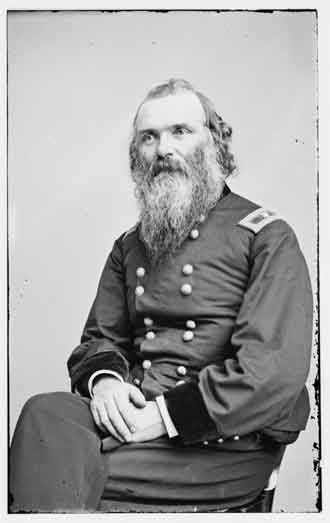
Library of Congress LC-DIG-cwpb-05905
Little
known General Daniel McCallum - Military Director and Superintendent of
railroads in the United States during the Civil War.
McCallum
was
the administrative genius behind the United States Military Railroad.
He is credited with the invention of the modern management
system
used in all large corporations to this day. More well
known Haupt makes it clear that McCallum took care of the requisitions,
accounts and "red tape", which he did not care to learn. Haupt's
autobiography cane be found online http://books.google.com/books?id=C3t2AAAAMAAJ&dq=Herman+Haupt+autobiography&source=gbs_navlinks_s.
City Point
Facts
| Size
of large storehouse complex |
1000 feet long by 50 feet wide |
| Length of wharf |
greater than 1/2 mile |
Back
to Mike's
Hobby Home Page









